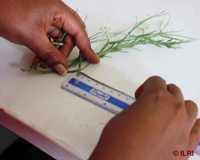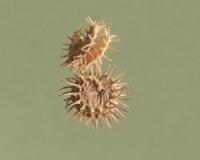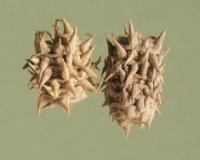Characterization of forage legume genetic resources
Contributors to this page: ILRI, Ethiopia (Jean Hanson); ICARDA, Syria (Ahmed Amri, Kenneth Street, Ali Shehadeh, Natalya Rukhkyan); GRCTPL, Australia (Richard Snowball); Bioversity International/ILRI, Ethiopia (Alexandra Jorge).
|
Contents: |
Planting and cultural practices for characterization
Environment
- The environment is selected based on species adaptation. Click on the herbaceous or fodder tree tropical and Mediterranean legumes tables for specific information (the environment should be suited to the species for the traits to be expressed for characterization).
Soil type
- Soil type is selected based on species adaptation. Click on the herbaceous or fodder tree tropical and Mediterranean legumes tables for specific information (the soil type should be suited to the species for good growth).
Rainfall
- Rainfall of 1000-1200 mm or >350 mm or 500 mm with irrigation is suitable for most forage species. Irrigate the field directly after sowing if first rain is delayed. Supplementary irrigation should be applied as necessary to ensure adequate seed yield to measure seed traits (sufficient rainfall or supplementary irrigation is essential for flowering and seed set to observe floral traits).
Season
- Data is usually recorded at 50% flowering for forages. This may be the end of the wet season for annuals and anytime that flowering occurs for perennials (morphological data is best taken at plant maturity when 50% of the plants are flowering).
Plot size
- Either plots of 2 m2 or single rows of at least 1-2 m long for herbaceous and 10-20 m long for fodder trees per accession with up to 90 cm between rows, depending on species (plot size should be large enough to accommodate at least ten plants for data collection).
Sampling area/border area
- Quadrates of 50 cm to 1 m for yield and ten plants from within the centre of the plot for morphological traits (this has been shown to be statistically acceptable for forage crops).
Plant density
- Plant density is selected on species adaptation. Click on the herbaceous or the fodder tree tropical and Mediterranean legumes tables for species specific information (this has been shown to be statistically acceptable for forage crops).
Replications
- Phenotypic traits should be measured on ten plants selected at random from each accession (this has been shown to be statistically acceptable for forage crops by van de Wouw et al, 1999). Biomass should be measured on plant samples for nutritional analysis taken from a minimum of three replications and preferably four. If replicates are used, phenotypic traits can be measured on ten plants across replications.
Standard check cultivars
- None are used since there are few cultivars for many forages.
Frequency of standard checks
- Not applicable.
Time of day for data collection
- Time of day is selected for each species for when flowers are open.
Morphological descriptors for characterization
See the list of forage legumes descriptors developed by IBPGR (now Bioversity International) and the CEC Secretariat, Brussels (1984).
Specific descriptors are available for:
- Cajanus cajan (L.) Millsp.
- Lathyrus spp.
- Lupinus
- Medicago
- Trifolium repens L.
- Vicia faba L.
- Vigna unguiculata L.
 |
 |
 |
|
Flowers of accession 7679 (Lathyrus Sativus) (photo: ILRI) |
Characterization of Lathyrus Sativus (photo: ILRI) |
Measuring stems of Lathyrus Sativus (photo: ILRI) |
Pictures for characterization
Sufficient detail should be captured in images to taxonomically identify the plant and demonstrate the traits that show variation.
- Take images for characters which may be difficult to describe verbally.
- Images of the whole plant, racemes (if applicable), flowers, pods.
- Store in a database file linked to other characterization data.
 |
 |
|
|
Taking images is very important to show characteristics. Note how hard it would be to describe the above legumes verbally (left: Medicago polymorpha var. vulgaris, right: Medicago truncatula) (photos: ICARDA) |
||
Herbarium samples for characterization
Sufficient detail should be captured to taxonomically identify the plant and demonstrate the traits that show variation.
- Take and store vouchers for future reference and taxonomic verification.
- Collect plants with leaves, flowers and pods, also roots if plants are small.
- Spread plants open before pressing and arrange leaves and flowers to show both sides or any specific traits.
Molecular descriptors for characterization
- SSR, EST-SSR, AFLP, RAPD (more efficient techniques).
Nutritional traits for characterization
The main use of forages is for livestock feed. Nutritional traits are therefore very important. Some common ones include:
- Crude protein.
- Minerals (P, K, Ca).
- Palatability.
- Digestibility.
- Fibre (neutral detergent fibre, Acid detergent fibre).
- Lignin.
- Anti-nutritional factors (tannins, saponins, alkaloids, non-protein amino acids).
- ODAP content for Lathyrus spp.
|
|
Recording information during characterization
The following information must be recorded for each trial:
General information
- Site (name of site with coordinates if possible).
- Planting date (date of sowing/planting).
- Harvesting date (date when plot was harvested - for nutritional/yield traits).
- Data collection date (date when data was collected).
- Data collector (full name).
- Trial identifier (reference number for trial).
Specific information
- See the list of forage legumes descriptors developed by IBPGR (now Bioversity International) and the CEC Secretariat, Brussels (1984).
- See also the characterization sheet used at ILRI.
References and further reading
IBPGR. 1992. Descriptors for White Clover (Trifolium repens). International Board for Plant Genetic Resources, Rome, Italy. 52 pp.
IBPGR, CEC, 1984. Forage Legume Descriptors. International Board for Plant Genetic Resources Secretariat, Rome, Italy: Commission of European Communities Secretariat, Brussels. Available from: http://www2.bioversityinternational.org/publications/Web_version/421/. Date accessed: 17 Jan 2011.
Van de Wouw M, Hanson J, Nokoe S. 1999. Observation strategies for morphological characterization of forages. Genetic Resources and Crop Evolution 46:63-71.
Click here for a list of selected references on characterization of forage legume genetic resources.
Comments
- No comments found





Leave your comments
Post comment as a guest